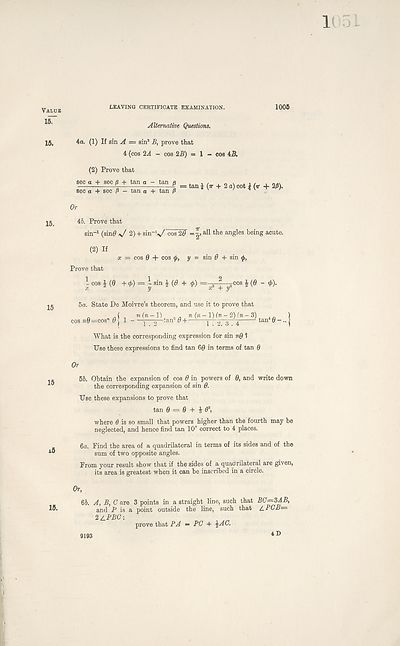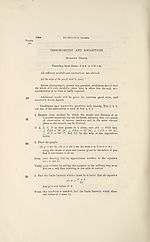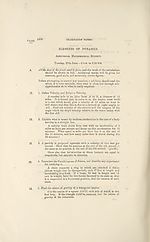Download files
Complete book:
Individual page:
Thumbnail gallery: Grid view | List view

LEAVING CERTIFICATE EXAMINATION.
1005
Value
isT
15.
15.
15
15
i5
15.
Alternative Questions.
4a. (1) If sin A = sin2 B, prove that
4 (cos 2A - cos 2B) = 1 - cos 45.
(2) Prove that
sec a + sec j3 + tan a - tan p
sec a + sec |3 - tan a + tan P
= tani (tt + 2a)cot |(v + 2/S).
Or
4&. Prove that
sin-1 (sin^ >/ 2) + sin~V cos 20 =|» all the angles being acute.
(2) If
a: = cos 0 + cos 0, y = sin 0 + sin <f>,
Prove that
1 cos J (0 + ^) = l sin i (0 + tp) =-a;a ^,"y?cos “ '/>)•
5a. State De Moivre’s theorem, and use it to prove that
„ . ,( n n(n-l)(n-2)(n-3)^ in )
os i?0=cosn 0 1 - ——tan2 0 + —^ y~~ 2'“ 3 4 ' tan ® 1
What is the corresponding expression for sin nQ 1
Use these expressions to find tan 60 in terms of tan 0
Or
56. Obtain the expansion of cos 0 in powers of 0, and write down
the corresponding expansion of sin 0.
Use these expansions to prove that
tan 0 = 0 + i 03,
where Q is so small that powers higher than the fourth may be
neglected, and hence find tan 10° correct to 4 places.
6a. Find the area of a quadrilateral in terms of its sides and of the
sum of two opposite angles.
From your result show that if the sides of a quadrilateral are given,
its area is greatest when it can be inscribed in a circle.
Or,
. A, B, C are 3 points in a straight line, such that
and P is a point outside the line, such that
2S.PBC\
nrnve that PA = PC ■
BC—3AB,
a.pcb=
9193
4 D
1005
Value
isT
15.
15.
15
15
i5
15.
Alternative Questions.
4a. (1) If sin A = sin2 B, prove that
4 (cos 2A - cos 2B) = 1 - cos 45.
(2) Prove that
sec a + sec j3 + tan a - tan p
sec a + sec |3 - tan a + tan P
= tani (tt + 2a)cot |(v + 2/S).
Or
4&. Prove that
sin-1 (sin^ >/ 2) + sin~V cos 20 =|» all the angles being acute.
(2) If
a: = cos 0 + cos 0, y = sin 0 + sin <f>,
Prove that
1 cos J (0 + ^) = l sin i (0 + tp) =-a;a ^,"y?cos “ '/>)•
5a. State De Moivre’s theorem, and use it to prove that
„ . ,( n n(n-l)(n-2)(n-3)^ in )
os i?0=cosn 0 1 - ——tan2 0 + —^ y~~ 2'“ 3 4 ' tan ® 1
What is the corresponding expression for sin nQ 1
Use these expressions to find tan 60 in terms of tan 0
Or
56. Obtain the expansion of cos 0 in powers of 0, and write down
the corresponding expansion of sin 0.
Use these expansions to prove that
tan 0 = 0 + i 03,
where Q is so small that powers higher than the fourth may be
neglected, and hence find tan 10° correct to 4 places.
6a. Find the area of a quadrilateral in terms of its sides and of the
sum of two opposite angles.
From your result show that if the sides of a quadrilateral are given,
its area is greatest when it can be inscribed in a circle.
Or,
. A, B, C are 3 points in a straight line, such that
and P is a point outside the line, such that
2S.PBC\
nrnve that PA = PC ■
BC—3AB,
a.pcb=
9193
4 D
Set display mode to:
![]() Universal Viewer |
Universal Viewer | ![]() Mirador |
Large image | Transcription
Mirador |
Large image | Transcription
Images and transcriptions on this page, including medium image downloads, may be used under the Creative Commons Attribution 4.0 International Licence unless otherwise stated. ![]()
| Scottish school exams and circulars > Leaving Certificate Examination > (55) |
|---|
| Permanent URL | https://digital.nls.uk/144136672 |
|---|
| Shelfmark | P.P. 1906 XXX |
|---|---|
| Attribution and copyright: |
|
| Description | Examination papers for the School Leaving Certificate 1888-1961 and the Scottish Certificate of Education 1962-1963. Produced by the Scotch (later 'Scottish') Education Department, these exam papers show how education developed in Scotland over this period, with a growing choice of subjects. Comparing them with current exam papers, there are obvious differences in the content and standards of the questions, and also in the layout and use of language |
|---|---|
| Additional NLS resources: |
|



